A British player finally wins Wimbledon again, a teenager becomes an overnight star, a pregnant player destroys the field and the next generation starts to break on through. This was tennis on the ATP and WTA tours in the 2010s.
It was a decade which commenced with the continued domination of Roger Federer and Rafael Nadal on the men's side. Then, in 2011, Novak Djokovic altered his diet and with that, everything changed.
Serena Williams spearheaded the women's game once more, scattering her grand slam victories over the first seven years of the decade but the iconic 23-time major winner didn't have the place all to herself. Meanwhile, the five-time grand slam champion Maria Sharapova's fall from grace was sharp following her doping ban.
The kids are alright
Let's work backwards. The recent ATP Finals in London - the penultimate to be held at The O2 before it switches to Turin in 2021 - was the potential dawning of a new era as Stefanos Tsitsipas, aged only 21, defeated Dominic Thiem (26) in the decider.
The Big Three had been eliminated as Federer (38), Djokovic (32) and Nadal (33) shared centre stage with the remaining eight best players in the world, including the aforementioned duo, the 2018 ATP Finals champion Alexander Zverev (22), the 2019 US Open finalist Daniil Medvedev (23) and the rising Italian star and US Open semifinalist, Matteo Berrettini (23).
A year ago, Tsitsipas won the ATP Next Gen tournament, the junior equivalent of the above, and was first reserve in 2017. The Greek superstar decisively defeated Federer at this year's Australian Open and repeated the trick at the semi-final stage of the ATP Finals. The times are changing at the elite level of the game.
In essence, it's the healthiest the male side of the sport has been for quite some time as genuine young pretenders finally emerge to challenge the hegemony of the Big Three.
 File photo dated 17-11-2019 of Stefanos Tsitsipas celebrates with the trophy after winning against Dominic Thiem on day eight of the Nitto ATP Finals at The O2 Arena, London.
File photo dated 17-11-2019 of Stefanos Tsitsipas celebrates with the trophy after winning against Dominic Thiem on day eight of the Nitto ATP Finals at The O2 Arena, London.The WTA Tour has seen a conveyor belt of grand slam champions over the last 10 years. In the 40 majors played this past decade, there have been 18 different winners, including eight one-time-only victors; Francesca Schiavone, Samantha Stosur, Marion Bartoli, Flavia Pennetta, Jeļena Ostapenko, Sloane Stephens, Ashleigh Barty and Bianca Andreescu, who won the last grand slam of the decade at Flushing Meadows this year.
Andreescu, at 19, possesses the talent to be the world's best barring injury, which is proving to be an unwelcome and regular occurrence in the Canadian's burgeoning career.
The women's game is wide open at present for one dominant figure to emerge. The current world number one, Barty (23), has a solitary grand slam - the 2019 French Open - and is the holder of the WTA Finals title, AKA. the Australian is by no means a runaway leader of the pack.
 (191103) -- SHENZHEN, Nov. 3, 2019 (Xinhua) -- Ashleigh Barty of Australia celebrates during the awarding ceremony after the singles final against Elina Svitolina of Ukraine at the WTA Finals Tennis Tournament in Shenzhen, south China's Guangdong Province, Nov. 3, 2019. (Xinhua/Liang Xu)
(191103) -- SHENZHEN, Nov. 3, 2019 (Xinhua) -- Ashleigh Barty of Australia celebrates during the awarding ceremony after the singles final against Elina Svitolina of Ukraine at the WTA Finals Tennis Tournament in Shenzhen, south China's Guangdong Province, Nov. 3, 2019. (Xinhua/Liang Xu)Whatever about the world number one slot, the breakout star of the year - and possibly of the decade - is the 15-year-old Coco Gauff. The young American burst onto the scene at Wimbledon this year and became an overnight star by defeating Venus Williams in the first round. She made a significant step in making it to the second week of Wimbledon at the first time of asking, before falling to the eventual champion Simona Halep in the fourth round.
On the morning of her first round clash, a single supporter approached Gauff for an autograph. Before the day was out, the teenager had made worldwide news. She is now a star. The next decade will be fascinating to watch.
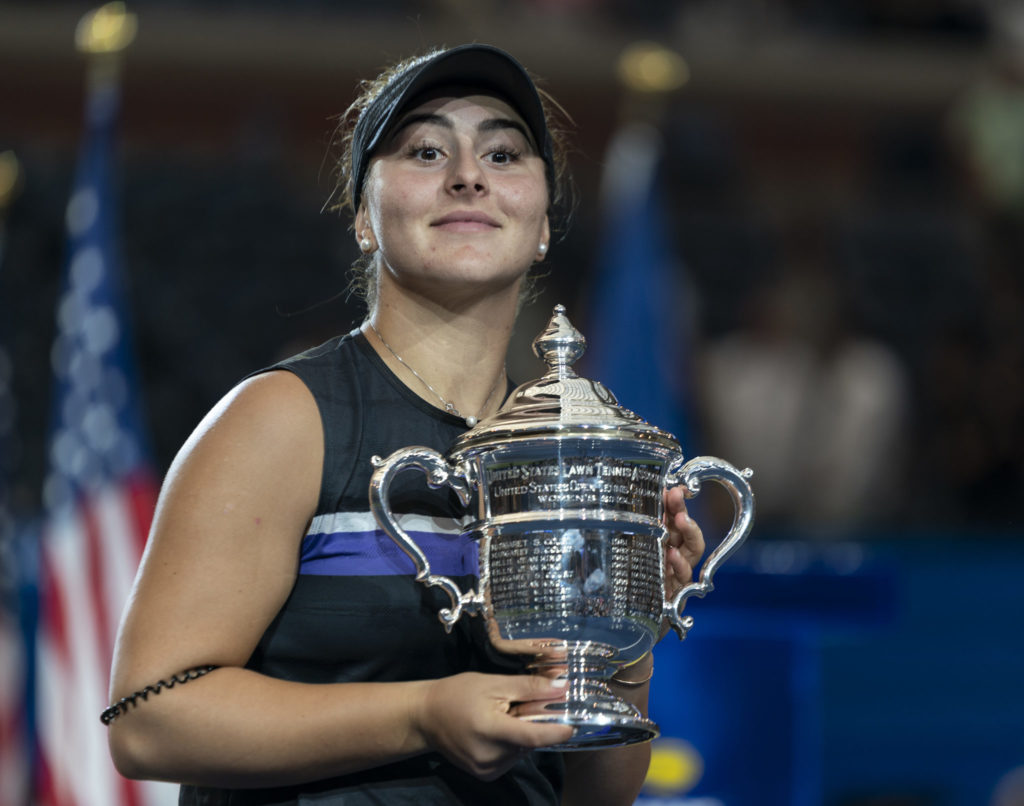 September 7, 2019, New York, New York, United States: Bianca Andreescu (Canada) poses with trophy after winning womens final match at US Open Championships against Serena Williams (USA) at Billie Jean King National Tennis Center (Credit Image: © Lev Radin/Pacific Press via ZUMA Wire)
September 7, 2019, New York, New York, United States: Bianca Andreescu (Canada) poses with trophy after winning womens final match at US Open Championships against Serena Williams (USA) at Billie Jean King National Tennis Center (Credit Image: © Lev Radin/Pacific Press via ZUMA Wire)The headline-making story of the decade, meanwhile, may very well have been Maria Sharapova and her initial two-year doping ban (it was reduced to 15 months on appeal). The Russian - who has won each of the four slams - tested positive for meldonium at the Australian Open in 2016.
Sharapova had been legally using meldonium because of health issues for many years. The medication was reclassified at the start of 2016. The two-time Roland Garros winner has always maintained that she was unaware of the official reclassification of the medication. Her ban was reduced as the court of arbitration for sport felt that she had not been intentionally doping.
The 32-year-old is back fighting and competing at the top level of the women's game as she looks to add another grand slam title for the first time since winning the 2014 French Open.
Andy Murray finally does it... and then refuses to give up
It was a decade of two halves for the former world number one.
The Scot started the 2010s by reaching the first grand slam final of the decade (his second major decider after reaching the 2008 US Open final). Murray, though, was dismantled by Federer in straight sets in that Australian Open final and would lose another four finals Down Under by the time 2016 was barely a month old.
Murray also lost the French Open final later that year but would win Wimbledon a matter of weeks on by easily defeating the Canadian, Milos Raonic.
It was Murray's second Wimbledon Championship of the decade after beating Djokovic in 2013 in straight sets on centre court to become the first British male player in 77 years to win at the All England Club.
The Glaswegian had reached the final the year prior but had a tearful loss to Federer before hammering the iconic Swiss later that summer to win gold at the Olympic Games and followed this landmark achievement by beating Djokovic over four hours and 54 minutes of a five-set-thriller in the 2012 US Open final. That was his first major victory.
Then things went array.
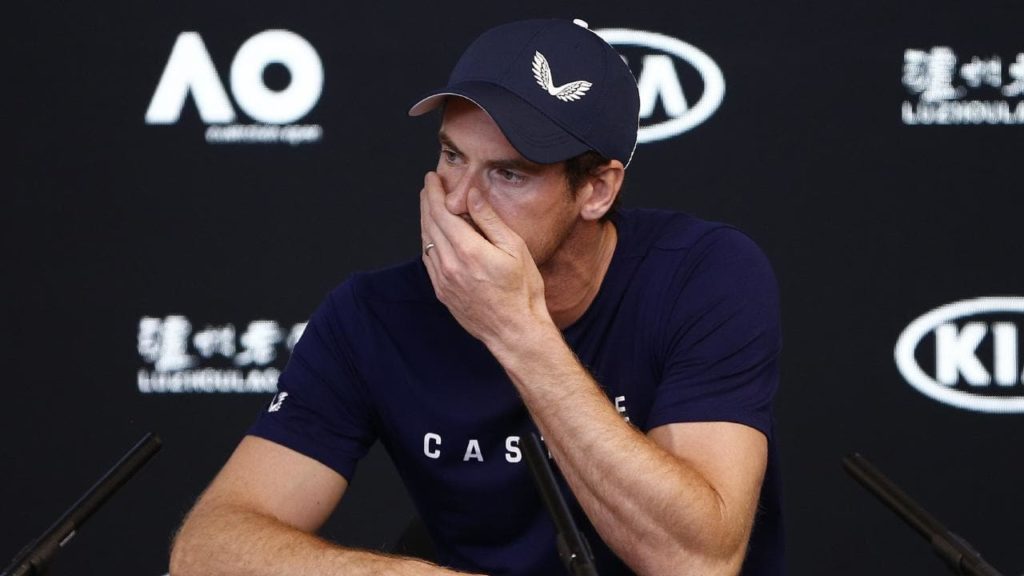
The second half of the decade was less acclaimed as Murray suffered injury-upon-injury culminating in an emotional press conference before the Australian Open last January, where the three-time grand slam champion, in a pre-tournament press conference, very publicly feared for the future of his career, citing a persistent and debilitating hip injury he continued to suffer.
Murray lost in the first round over five sets to the talented Roberto Bautista Agut and then received an on-court video message from his peers, congratulating Murray on a fantastic career which looked to be finished.
However, Murray remained. He returned post-surgery, initially competing in doubles, as he did at this year's Wimbledon in both the men's and mixed competitions; partnering with Serena Williams in the latter.
The aim was to return to singles action and, so, the comeback was complete on that front when Murray won the European Open final in Antwerp against Stan Wawrinka at the end of October. It was arguably Murray's most impressive achievement of a remarkable decade.
A year on from looking like it was all over in Melbourne, Murray is due to compete in the men's singles competition at the 2020 Australian Open. Amazing.
Serena Williams and her unique strength of character
Eight weeks. Serena Williams was eight weeks pregnant when she won the 2017 Australian Open.
Fittingly, the occasion was a family affair as Serena beat older sister Venus - their first grand slam showdown since the 2009 Wimbledon decider - in straight sets to clinch her 23rd grand slam. Williams didn't drop a set en route to winning in Melbourne while carrying her first child, Alexis Olympia, who was born later in the year.
From 2010 to 2017, Williams won 12 grand slams. The aforementioned victory put the Michigan native's grand slam haul just one behind Margaret Court's all-time record of 24 titles. Nearly three years on, though, Williams has failed to match that milestone.
Incredibly, she has reached four grand slam finals since her season-long break ended after giving birth, but she has lost them all, including the ill-tempered 2018 US Open final against Naomi Osaka when Williams so controversially clashed with chair umpire Carlos Ramos.
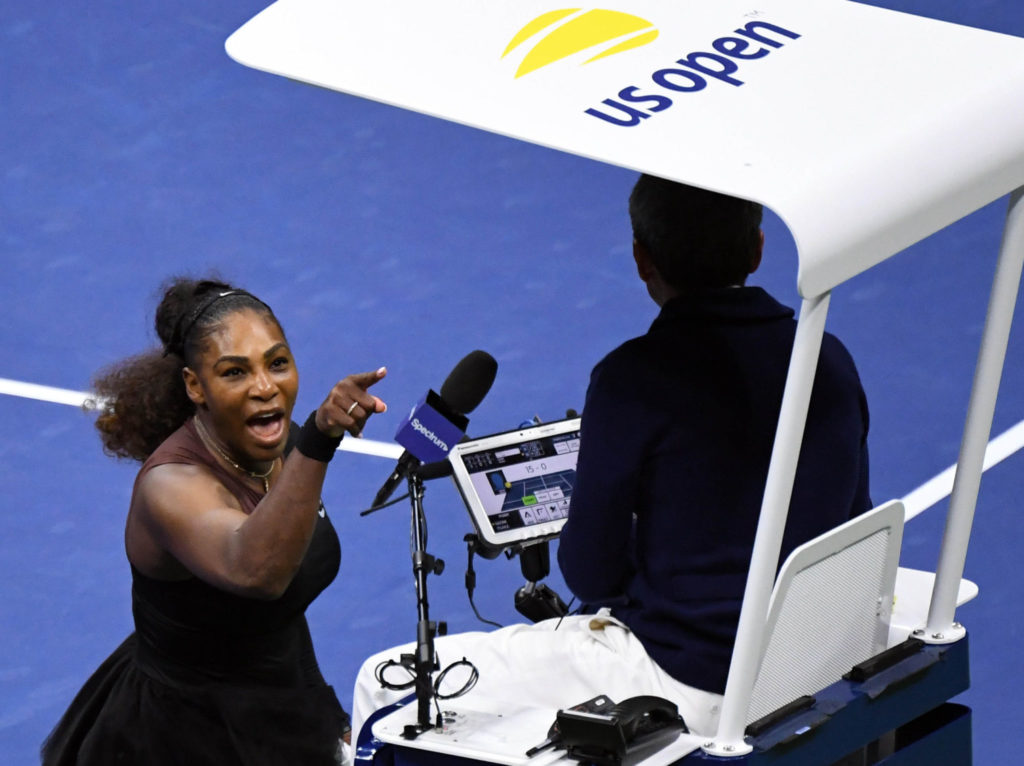 Sep 8, 2018; New York, NY, USA; Serena Williams of the United States yells at chair umpire Carlos Ramos in the women's final against Naomi Osaka of Japan on day thirteen of the 2018 U.S. Open tennis tournament at USTA Billie Jean King National Tennis Center. Mandatory Credit: Danielle Parhizkaran-USA TODAY SPORTS
Sep 8, 2018; New York, NY, USA; Serena Williams of the United States yells at chair umpire Carlos Ramos in the women's final against Naomi Osaka of Japan on day thirteen of the 2018 U.S. Open tennis tournament at USTA Billie Jean King National Tennis Center. Mandatory Credit: Danielle Parhizkaran-USA TODAY SPORTSPrior to that infamous night in New York and only a short time after returning from her maternity leave, Williams lost to Angelique Kerber in the Wimbledon final in what was the German's first victory at SW19. The result was to repeat itself in the 2019 final on centre court as Halep, who entered the contest with an atrocious record against Williams, triumphed. The Romanian won with ease; 6-2, 6-2.
The scoreline followed a trend in Williams' grand slam final record since returning from her hiatus - each defeat was a straight-sets loss. By the time she was preparing for the 2019 US Open final against Andreescu, the talk was not just about whether she would finally match Court's unparalleled magic number, but also of her nerve.
 File photo dated 09-07-2016 of Serena Williams celebrates winning the ladies singles final on day twelve of the Wimbledon Championships at the All England Lawn Tennis and Croquet Club, Wimbledon.
File photo dated 09-07-2016 of Serena Williams celebrates winning the ladies singles final on day twelve of the Wimbledon Championships at the All England Lawn Tennis and Croquet Club, Wimbledon.It proved to be a significant debate. Williams steamrolled into the final but, once again, went down in straight sets as arguably the most dominant competitor in the history of female tennis waits for that elusive no. 24.
While time is not on her side at 38 years of age, her competitive spirit remains untouched. The following 12 months will be telling.
The Big Three call the shots
When the initial ATP rankings of the decade were released on January 4th, 2010, the top three in the world read, in descending order: Federer, Nadal, Djokovic. The final rankings of the 2010s, in the same 1-2-3 order? Nadal, Djokovic, Federer. The more things change the more they stay the same.
The most casual tennis fan will tell you that when discussing these three titans, you are talking about possibly the three best players to ever have picked up a racket.
However, the staunchest supporter of the game would have struggled to predict the continued dominance of the trio this past ten years when glancing at those rankings way back in the first week of the decade, bearing in mind their ageing years and increased family commitments.
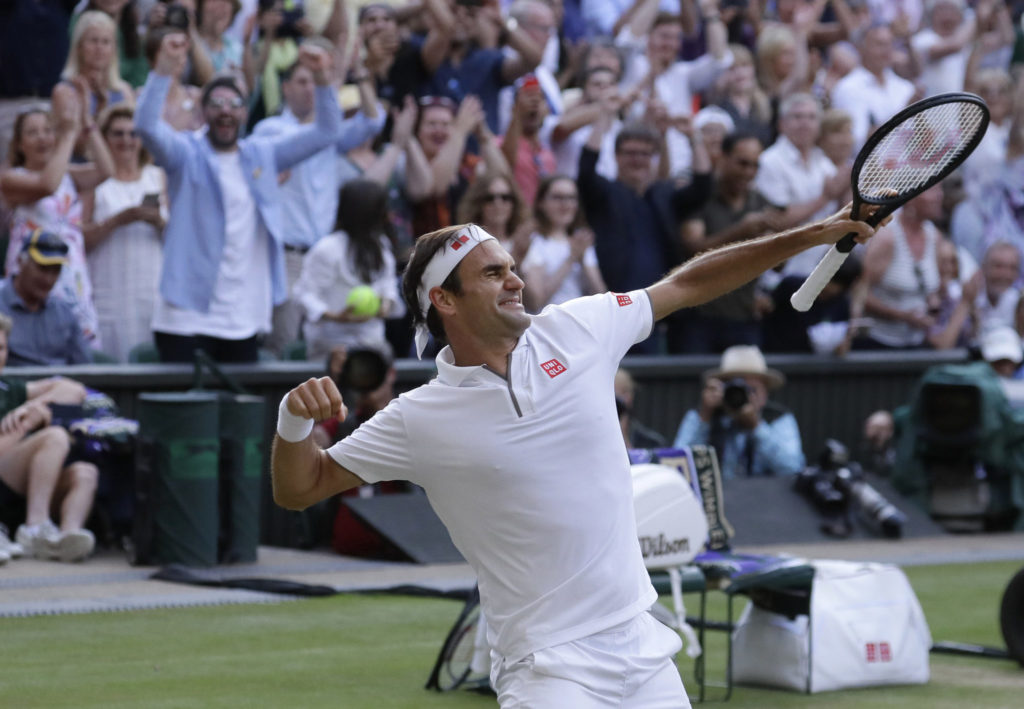 Switzerland's Roger Federer celebrates after beating Spain's Rafael Nadal in a Men's singles semifinal match on day eleven of the Wimbledon Tennis Championships in London, Friday, July 12, 2019. (AP Photo/Kirsty Wigglesworth)
Switzerland's Roger Federer celebrates after beating Spain's Rafael Nadal in a Men's singles semifinal match on day eleven of the Wimbledon Tennis Championships in London, Friday, July 12, 2019. (AP Photo/Kirsty Wigglesworth)Entering the 2010s, the status of Federer and Nadal was unquestionable. Federer had run the show in the 2000s, winning every one of the four majors at least once, including six Wimbledon Championships (five on the bounce) and five consecutive US Open crowns. Meanwhile, Nadal had already established himself as the greatest clay court player around, picking up four French Open titles in a row and defeating Federer at the peak of his dominance in the 2008 Wimbledon final, oft-considered the best professional tennis match in living memory.
Djokovic, on the other hand, was the best of the rest. The Serbian's talent was indisputable and he showcased this when getting the better of Jo-Wilfried Tsonga in the 2008 Australian Open final, but he lacked the consistency required to regularly compete with Federer and Nadal. Everyone did.
That was until Djokovic altered his approach at the beginning of the decade and, after going gluten-free in 2011, enjoyed a remarkable upsurge in form and eventual dominance. His statistics are quite remarkable. Djokovic has won 15 of his 16 grand slam titles in the past decade, accumulated 61 titles in total over the past ten years and earned in excess of $100 million in tournament prize money alone in the process.
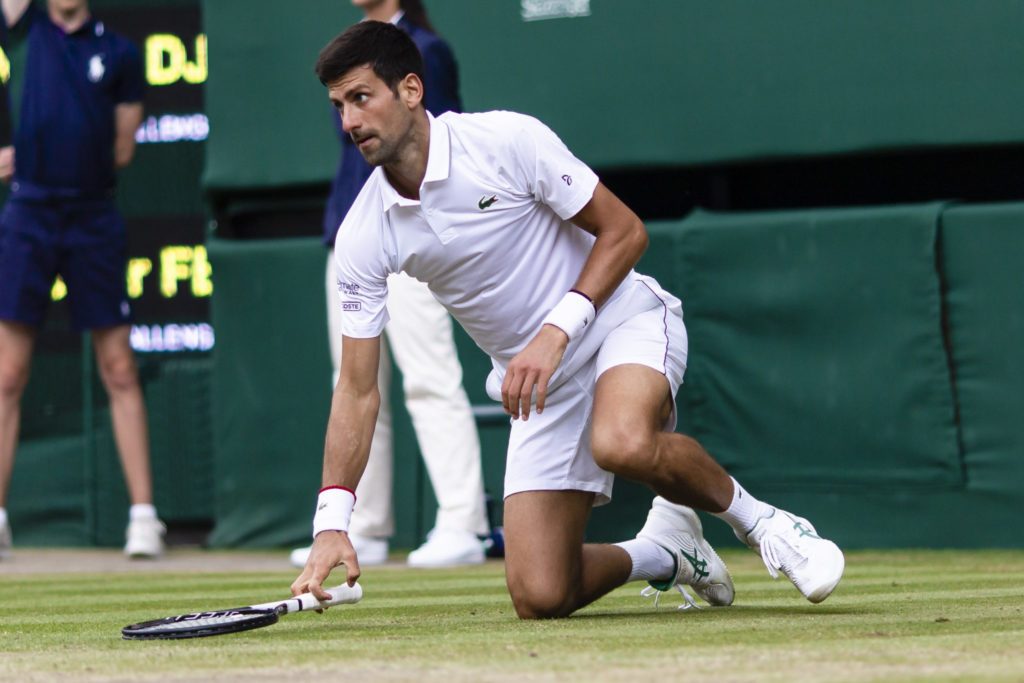 14 July 2019, Great Britain, London: Tennis: Grand Slam/ATP Tour, Wimbledon, Individual, Men, Final, Djokovic (Serbia) - Federer (Switzerland). Novak Djokovic kneels on the lawn after a fall. Photo: Frank Molter/dpa
14 July 2019, Great Britain, London: Tennis: Grand Slam/ATP Tour, Wimbledon, Individual, Men, Final, Djokovic (Serbia) - Federer (Switzerland). Novak Djokovic kneels on the lawn after a fall. Photo: Frank Molter/dpaThe peak of this stupendous form was mid-2015 through to mid-2016, when Djokovic held all four grand slam titles at once heading into the 2016 Wimbledon Championships. Earlier this year in the Wimbledon final, Djokovic saved two championship points to beat Federer in a five-set thriller that lasted just three minutes shy of five hours, making it the longest Wimbledon final of the modern era and the first grand slam to be decided by a final set tiebreak.
Unlike Federer in the previous decade though, the spoils have been more evenly shared. It hasn't been all about Djokovic. Federer and Nadal added five and 13 grand slam titles respectively to their overall haul. The Spaniard ended the decade as the world's best player and clinched his 12th Roland Garros when seeing off Thiem earlier this year as Djokovic's form tailored off slightly in the last 12 months.
Federer is still at the top of the mountain with his 20 grand slam titles, compared to Nadal's 19 and Djokovic's 16 in total. The questions remains: who will have the most when it's all said and done?
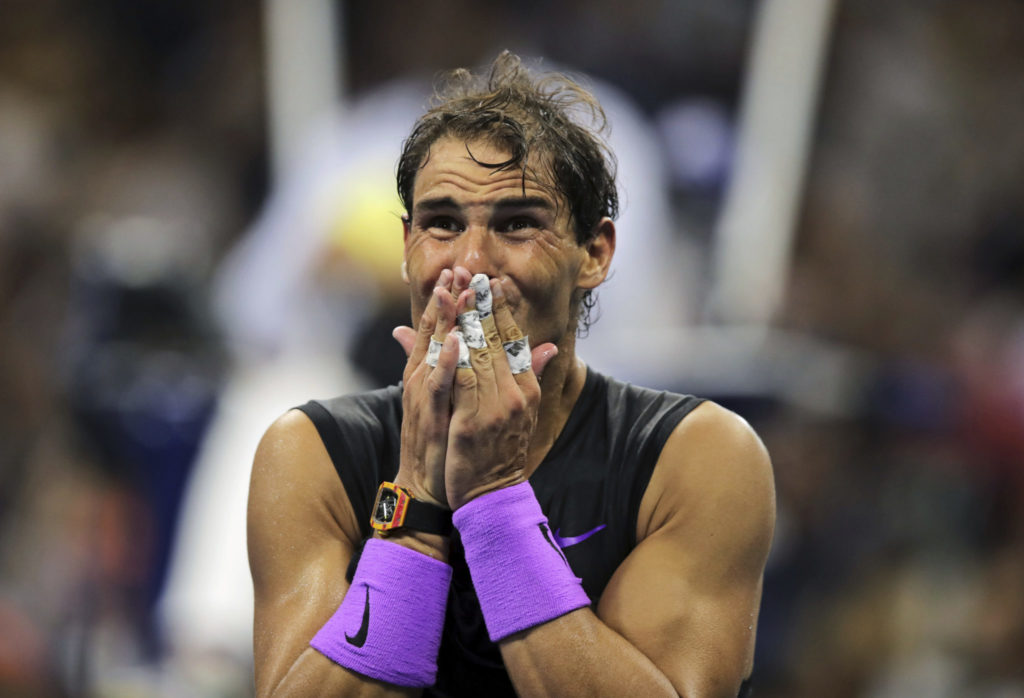 Rafael Nadal, of Spain, reacts after defeating Daniil Medvedev, of Russia, to win the men's singles final of the U.S. Open tennis championships Sunday, Sept. 8, 2019, in New York. (AP Photo/Charles Krupa)
Rafael Nadal, of Spain, reacts after defeating Daniil Medvedev, of Russia, to win the men's singles final of the U.S. Open tennis championships Sunday, Sept. 8, 2019, in New York. (AP Photo/Charles Krupa)It all means that the perception of the men's game is in an odd place: should fans embrace and appreciate the same three players dominating proceedings more often than not or is there cause for concern for the future of the game? The only men to have won a grand slam in the last decade besides the Big Three are Murray (as mentioned above), Wawrinka (2014 Australian Open; 2015 French Open; 2016 US Open) and Marin Čilić (2014 US Open).
On the bright side, the end of the decade coincided with an influx of superb new talent which outshone the Big Three on the odd occasion. Add to that genuine entertainers in Nick Kyrgios, Félix Auger-Aliassime, Gaël Monfils and Kei Nishikori, and the game is in good stead.
One thing is for certain: in ten years' time, we will be looking at a new top three in the world and we'll finally find out if Serena did indeed catch Court.
Download the brand new OffTheBall App in the Play Store & App Store right now! We've got you covered!
Subscribe to OffTheBall's YouTube channel for more videos, like us on Facebook or follow us on Twitter for the latest sporting news and content.








